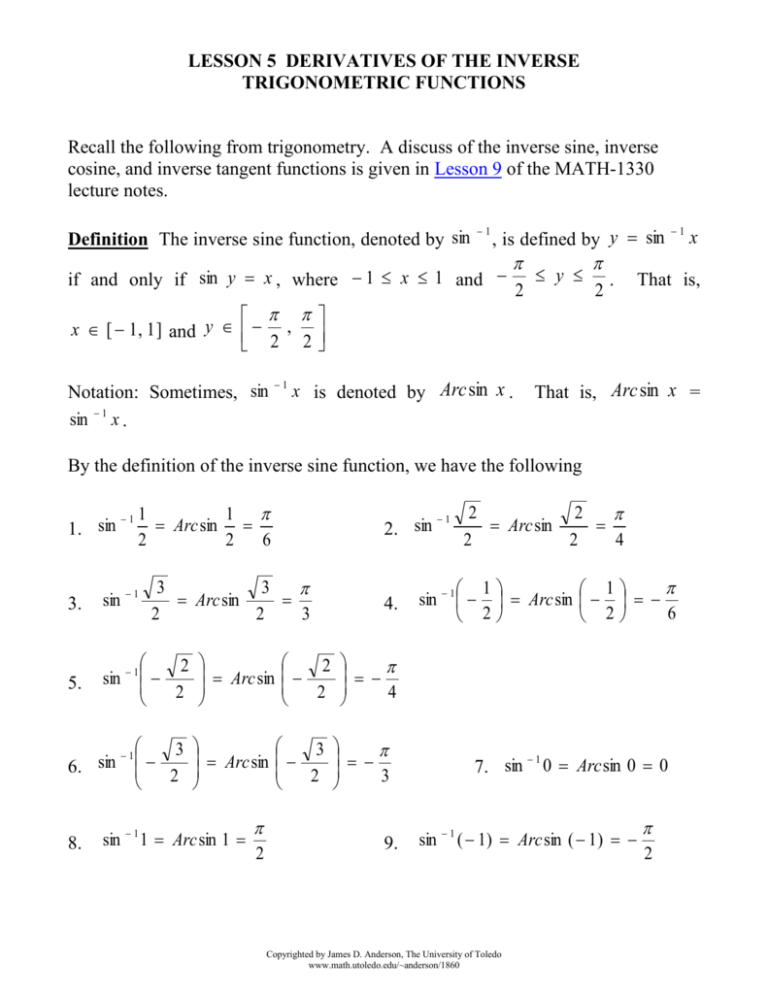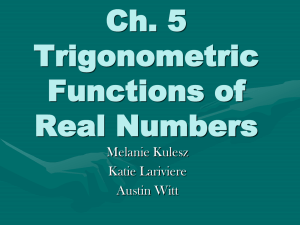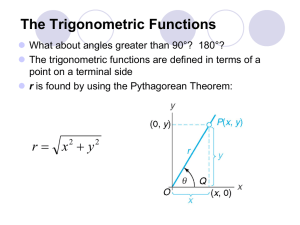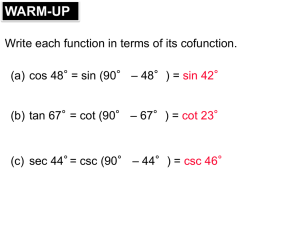Lesson 5 Derivatives of the Inverse
advertisement

LESSON 5 DERIVATIVES OF THE INVERSE
TRIGONOMETRIC FUNCTIONS
Recall the following from trigonometry. A discuss of the inverse sine, inverse
cosine, and inverse tangent functions is given in Lesson 9 of the MATH-1330
lecture notes.
Definition The inverse sine function, denoted by sin
1
, is defined by y sin
if and only if sin y x , where 1 x 1 and
x [ 1, 1 ] and y ,
2 2
Notation: Sometimes, sin
sin 1 x .
1
y .
2
2
x is denoted by Arc sin x .
1
That is,
That is, Arc sin x =
By the definition of the inverse sine function, we have the following
1
1. sin
1
1
Arc sin
2
2
6
3
3
Arc sin
2
2
3
3.
sin 1
5.
2
Arc sin
sin 1
2
3
1
Arc sin
sin
6.
2
8.
1
2. sin
sin 1 1 Arc sin 1
2
4.
2
2
Arc sin
2
2
4
1
sin 1 Arc sin
2
1
6
2
2
2
4
3
2
3
9.
1
7. sin 0 Arc sin 0 0
sin 1 ( 1) Arc sin ( 1)
Copyrighted by James D. Anderson, The University of Toledo
www.math.utoledo.edu/~anderson/1860
x
2
1
Definition The inverse cosine function, denoted by cos , is defined by
y cos 1 x if and only if cos y x , where 1 x 1 and 0 y . That
is, x [ 1, 1 ] and y [ 0 , ]
1
Notation: Sometimes, cos x is denoted by Arc cos x .
cos 1 x .
That is, Arc cos x =
By the definition of the inverse cosine function, we have the following
1
1. cos
3.
cos 1
3
3
Arc cos
2
2
6
1
1
Arc cos
2
2 3
1
2. cos
2
2
Arc cos
2
2
4
3
3 5
1
cos
Arc
cos
4.
2
2
6
2
2 3
1
cos
Arc
cos
5.
2
2
4
1
1 2
1
6. cos Arc cos
3
2
2
8.
cos 1 1 Arc cos 1 0
1
7. cos 0 Arc cos 0
9.
2
cos 1 ( 1) Arc cos ( 1)
1
Definition The inverse tangent function, denoted by tan , is defined by
y tan 1 x if and only if tan y x , where x is any real number and
y . That is, y ,
2
2
2 2
1
Notation: Sometimes, tan x is denoted by Arc tan x .
tan 1 x .
That is, Arc tan x =
By the definition of the inverse tangent function, we have the following
Copyrighted by James D. Anderson, The University of Toledo
www.math.utoledo.edu/~anderson/1860
1
1. tan
1
1
Arc tan
6
3
3
1
2. tan 1 Arc tan 1
3
3.
tan 1 3 Arc tan
5.
tan 1 ( 1) Arc tan ( 1)
3
4.
4
1
1
tan 1
Arc tan
6
3
3
4
1
6. tan ( 3 ) Arc tan ( 3 )
3
1
7. tan 0 Arc tan 0 0
1
Definition The inverse cotangent function, denoted by cot , is defined by
y cot 1 x if and only if cot y x , where x is any real number and 0 y .
That is, y ( 0 , )
1
Notation: Sometimes, cot x is denoted by Arc cot x .
cot 1 x .
That is, Arc cot x =
By the definition of the inverse cotangent function, we have the following
1
3 Arc cot
1. cot
1
3. cot
5.
3
6
1
2. cot 1 Arc cot 1
1
1
Arc cot
3
3
3
cot 1 ( 1) Arc cot ( 1)
4
1
4. cot ( 3 ) Arc cot ( 3 )
5
6
3
4
1
1 2
1
cot
Arc
cot
6.
3
3
3
1
7. cot 0 Arc cot 0
Copyrighted by James D. Anderson, The University of Toledo
www.math.utoledo.edu/~anderson/1860
2
1
Definition The inverse secant function, denoted by sec , is defined by
or
2
3
3
y
0
,
y
x
(
,
1
]
[
1
,
)
. That is,
and
2
, 2 .
2
y sec 1 x if and only if sec y x , where x 1 and 0 y
1
Notation: Sometimes, sec x is denoted by Arc sec x .
sec 1 x .
That is, Arc sec x =
By the definition of the inverse secant function, we have the following
1
1. sec
3.
2
2
Arc sec
6
3
3
sec 1 2 Arc sec 2
1
5. sec (
2 ) Arc sec (
2
4
2
2 7
1
sec
Arc
sec
4.
6
3
3
3
1
6. sec ( 2 ) Arc sec ( 2 )
8.
1
2 Arc sec
2. sec
2)
4
3
5
4
1
7. sec 1 Arc sec 1 0
sec 1 ( 1) Arc sec ( 1)
1
Definition The inverse cosecant function, denoted by csc , is defined by
or
2
3
3
y
0
,
y
,
x
(
,
1
]
[
1
,
)
. That is,
and
.
2
2
2
y csc 1 x if and only if csc y x , where x 1 and 0 y
1
Notation: Sometimes, csc x is denoted by Arc csc x .
csc 1 x .
That is, Arc csc x =
By the definition of the inverse cosecant function, we have the following
Copyrighted by James D. Anderson, The University of Toledo
www.math.utoledo.edu/~anderson/1860
1
1. csc 2 Arc csc 2
1
3. csc
6
1
2 Arc csc
2. csc
2
2
Arc csc
3
3
3
1
5. csc (
2 ) Arc csc (
csc 1 ( 1) Arc csc ( 1)
4
1
4. csc ( 2 ) Arc csc ( 2 )
2)
7
6
5
4
2
2 4
1
csc
Arc
csc
6.
3
3
3
8.
2
1
7. csc 1 Arc csc 1
2
3
2
1
Theorem If f ( x ) sin x , then f ( x )
1
1 x2
.
NOTE: The domain of the function f is the set { x : 1 x 1 } = [ 1, 1 ] and the
domain of f is the set { x : 1 x 1 } = ( 1, 1) .
1
Proof Let y f ( x ) . Then y sin x . By the definition of the inverse sine
function, sin y x , where
y . Using implicit differentiation, we
2
2
obtain that y cos y 1 . Solving for y , we have that y
1
, where
cos y
cos
cos
0 . Since cos 2 y sin 2 y 1 for all y,
y
since
2
2
2
2
2
2
2
then cos y 1 sin y cos y 1 sin y . The angles y such that
y
are either in the I quadrant or IV quadrant. The cosine function is
2
2
positive in both of these quadrants. Thus, cos y
1 sin 2 y . Since sin y x ,
Copyrighted by James D. Anderson, The University of Toledo
www.math.utoledo.edu/~anderson/1860
then we have that cos y
1 x 2 . Thus, y
1 sin 2 y =
1
=
cos y
1
1 x2
.
1
Theorem If f ( x ) cos x , then f ( x )
1
1 x2
.
NOTE: The domain of the function f is the set { x : 1 x 1 } = [ 1, 1 ] and the
domain of f is the set { x : 1 x 1 } = ( 1, 1) .
1
Proof Let y f ( x ) . Then y cos x . By the definition of the inverse cosine
function, cos y x , where 0 y . Using implicit differentiation, we obtain
1
that ( sin y ) y 1 . Solving for y , we have that y
, where 0 y
sin y
2
2
2
2
since sin 0 sin 0 . Since cos y sin y 1 for all y, then sin y 1 cos y
sin y 1 cos 2 y . The angles y such that 0 y are either in the I
quadrant or II quadrant. The sine function is positive in both of these quadrants.
Thus, sin y
=
1 cos 2 y . Since cos y x , then we have that sin y
1
1
1 x 2 . Thus, y
=
.
sin y
1 x2
1
Theorem If f ( x ) tan x , then f ( x )
1 cos 2 y
1
.
1 x2
NOTE: The domain of the functions f and f is the set of all real numbers.
1
Proof Let y f ( x ) . Then y tan x . By the definition of the inverse tangent
function, tan y x , where
y . Using implicit differentiation, we
2
2
2
obtain that y sec y 1 . Solving for y , we have that y
1
. Since
sec 2 y
sec 2 y tan 2 y 1 for all y in the domain of the secant and tangent functions, then
Copyrighted by James D. Anderson, The University of Toledo
www.math.utoledo.edu/~anderson/1860
sec 2 y 1 tan 2 y . Since tan y x , then we have that sec 2 y 1 tan 2 y =
1
1
1 x 2 . Thus, y
=
.
1 x2
sec 2 y
1
Theorem If f ( x ) cot x , then f ( x )
1
.
1 x2
NOTE: The domain of the functions f and f is the set of all real numbers.
1
Proof Let y f ( x ) . Then y cot x . By the definition of the inverse cotangent
function, cot y x , where 0 y . Using implicit differentiation, we obtain
1
2
that ( csc y ) y 1 . Solving for y , we have that y
. Since
csc 2 y
csc 2 y cot 2 y 1 for all y in the domain of the cosecant and cotangent functions,
2
2
2
2
then csc y 1 cot y . Since cot y x , then we have that csc y 1 cot y =
1
1
1 x 2 . Thus, y
=
.
csc 2 y
1 x2
1
Theorem If f ( x ) sec x , then f ( x )
1
x x2 1
.
NOTE: The domain of the function f is the set { x : x 1 } = ( , 1] [1, )
and the domain of f is the set { x : x 1 } = ( , 1) (1, ) .
1
Proof Let y f ( x ) . Then y sec x .
function, sec y x , where y 0 ,
2
By the definition of the inverse secant
3
, 2 . Using implicit differentiation,
1
we obtain that y sec y tan y 1. Solving for y , we have that y
,
sec y tan y
3
y
0, ,
since tan 0 tan 0 . Since sec 2 y tan 2 y 1 for
where
2
2
2
2
all y in the domain of the secant and tangent functions, then tan y sec y 1
3
tan y sec 2 y 1 . The angles y such that y 0 , , are either in
2
2
Copyrighted by James D. Anderson, The University of Toledo
www.math.utoledo.edu/~anderson/1860
the I quadrant or III quadrant. The tangent function is positive in both of these
quadrants. Thus, tan y
tan y
sec 2 y 1 =
sec 2 y 1 . Since sec y x , then we have that
1
1
x 2 1 . Thus, y
=
.
sec y tan y
x x2 1
1
Theorem If f ( x ) csc x , then f ( x )
1
x x2 1
.
NOTE: The domain of the function f is the set { x : x 1 } = ( , 1] [1, )
and the domain of f is the set { x : x 1 } = ( , 1) (1, ) .
1
Proof Let y f ( x ) . Then y csc x . By the definition of the inverse secant
3
function, csc y x , where y 0 , , . Using implicit differentiation,
2
2
1
we obtain that ( csc y cot y ) y 1 . Solving for y , we have that y
,
csc y cot y
3
3
cot
0 . Since csc 2 y cot 2 y 1
where y 0 , , since cot
2
2
2
2
for all y in the domain of the cosecant and cotangent functions, then
cot 2 y csc 2 y 1 cot y csc 2 y 1 . The angles y such that
3
y 0, ,
are either in the I quadrant or III quadrant. The cotangent
2
2
function is positive in both of these quadrants. Thus, cot y
csc y x , then we have that cot y
1
1
y
=
.
csc y cot y
x x2 1
csc 2 y 1 =
csc 2 y 1 . Since
x 2 1 . Thus,
Summarizing, we have the following differentiation formulas:
1.
D x ( sin 1 x )
1
1 x2
2.
D x ( cos 1 x )
Copyrighted by James D. Anderson, The University of Toledo
www.math.utoledo.edu/~anderson/1860
1
1 x2
3.
D x ( tan 1 x )
1
1 x2
D x ( sec 1 x )
1
5.
x2 1
x
4.
D x ( cot 1 x )
1
1 x2
D x ( csc 1 x )
1
6.
x
x2 1
Theorem If u is a differentiable function of x, then
1
du
dx
1.
D x ( sin 1 u )
3.
D x ( tan 1 u )
1 du
1 u 2 dx
D x ( sec 1 u )
1
5.
1 u2
du
u u 2 1 dx
2.
4.
D x ( cot 1 u )
1 du
1 u 2 dx
D x ( csc 1 u )
1
6.
Proof Use the Chain Rule and the differentiation formulas above.
Examples Differentiate the following functions.
1.
f ( x ) sin 1 ( 5 x 3 )
f ( x )
1
1 (5x )
3 2
Answer: f ( x )
D x (5x ) =
3
15 x 2
1 25 x 6
15 x 2
1 25 x 6
y Arc cos ( 4 t )
2
2.
1
D x ( cos 1 u )
Copyrighted by James D. Anderson, The University of Toledo
www.math.utoledo.edu/~anderson/1860
1 u2
du
dx
du
u u 2 1 dx
2
t 4 t ln 16
dy
1
1
t2
t2
Dt ( 4 ) =
4 ( ln 4 ) 2 t =
2
t2 2
2t 2
dt
1 16 t
1 (4 )
14
2t
2 t
t
NOTE: 4 ( 4 ) 16
2
2
2
2
dy
t 4 t ln 16
Answer: dt
2
1 16 t
3.
h( u ) cot 1 ( 6 e 4 u )
1
e 4u 4
4u
h( u )
Du (6 e ) =
=
1 ( 6 e 4u ) 2
1 36 12 e 4 u e 8 u
4e 4u
37 12 e 4 u e 8 u
4e 4u
Answer: h( u )
37 12 e 4 u e 8 u
4.
3
y 6 x 5 Arc tan 2
7x
4
3
1
6 3
5
y 6 5 x Arc tan 2 x
x
9 7
=
7x
1
49 x 4
Copyrighted by James D. Anderson, The University of Toledo
www.math.utoledo.edu/~anderson/1860
3
6 5 x 4 Arc tan 2
7x
3
6 5 x 4 Arc tan 2
7x
7 1
6x2
9 =
49 x 4
7 1
6x2
49 x 4
4
9 49 x =
49 x 4
3
6 5 x 4 Arc tan
2
7x
294 x 6
7 ( 49 x 4 9 ) =
3
6 x 5 Arc tan
2
7x
294 x 2
7 ( 49 x 4 9 )
4
3
y
6
x
5
Arc
tan
Answer:
2
7x
4
5.
294 x 2
7 ( 49 x 4 9 )
g ( t ) ln sec 1 3 8 t 3
g ( t )
D t sec 1 3 8 t 3
sec 1 3 8 t 3
1
D t sec 1 3 8 t 3 =
3
1
3
8 t3
(8 t 3 ) 2/3
8 t3
(8 t 3 ) 2/3 1
D t ( 8 t 3 ) 1/ 3 =
1
( 8 t 3 ) 2 / 3 ( 3t 2 ) =
1 3
Copyrighted by James D. Anderson, The University of Toledo
www.math.utoledo.edu/~anderson/1860
1
( 8 t 3 ) 1/ 3
(8 t 3 ) 2/3
t2
3 2/3 =
1 (8 t )
t2
t2
(8 t 3 ) (8 t 3 ) 2/3 1
g ( t )
=
( t 3 8) (8 t 3 ) 2 / 3 1
D t sec 1 3 8 t 3
1
=
sec 1 3 8 t 3
sec 1 3 8 t 3
t2
( t 3 8) (8 t 3 ) 2 / 3 1
t2
( t 3 8 ) ( 8 t 3 ) 2 / 3 1 sec 1 3 8 t 3
Answer: g ( t )
6.
y csc
1
t2
( t 3 8 ) ( 8 t 3 ) 2 / 3 1 sec 1 3 8 t 3
x3
4
x3
D x
3
6
=
4
x
x
1
4
16
dy
dx
x3
4
1
3
x
= x
1
6
( x 16 )
4
16
dy
Answer: dx
x
3
x 6 16
1
1 6
( x 16 )
16
=
3x 2
4 =
12
x
x 6 16
12
x 6 16
Copyrighted by James D. Anderson, The University of Toledo
www.math.utoledo.edu/~anderson/1860
=
Example Find the equation (in point-slope form) of the tangent line to the graph of
x
y
Arc
cos
the function
at the point for which x 3 .
2
(
3
,
y
(
3
)
)
3
,
Tangent Point:
6
3
y( 3 ) Arc cos
2
6
1
D x ( x ) 1/ 2
=
2
x
1
4
1
( x ) 1/ 2 ( 1)
x 4
=
1
4
1
y
1
1
(4 x)
4
1
x
4
m tan y ( 3 )
Answer: y
6
1
1
2 3
3
6
= 1
2
4 x
1
1
4
x
1
=
2 x(4 x)
3
6
( x 3)
Example If s( t ) Arc cot ( 4 t 3 ) is the position function which gives the
position (in meters) of a particle at time t (in hours), then find (a) the instantaneous
velocity and (b) the instantaneous acceleration of the particle at time t 2 hours.
v ( t ) s ( t )
1
4
4
=
1 ( 4 t 3) 2
1 ( 4 t 3) 2
Copyrighted by James D. Anderson, The University of Toledo
www.math.utoledo.edu/~anderson/1860
v( 2 )
4
4
2
1 25
26
13
Answer for (a):
2 m
13 hr
4
2 1
v
(
t
)
Since
, then
2 = 4 [1 ( 4 t 3 ) ]
1 ( 4 t 3)
32 ( 4 t 3 )
a( t ) v ( t ) s( t ) 4 [1 ( 4 t 3 ) 2 ] 2 2 ( 4 t 3 ) 4 =
[1 ( 4 t 3 ) 2 ] 2
a( 2 )
32 ( 5 )
8(5)
32 ( 5 )
16 ( 5 )
32 ( 5 )
40
=
=
=
=
2 =
2
( 1 25 )
13 13
26 26
13 26
26
169
Answer for (b):
40 m
169 hr 2
1 3 x 12
y
tan
Examples Determine the interval(s) on which the function
x 2 9 is
increasing and decreasing. Then find the local maximum(s) and local minimum(s)
of the function.
y
3 x 12
2
D
x
2
x
9
3 x 12
=
1 2
x 9
1
1
3 ( x 2 9 ) ( 3 x 12 ) 2 x
=
( 3 x 12 ) 2
( x 2 9) 2
1
( x 2 9) 2
Copyrighted by James D. Anderson, The University of Toledo
www.math.utoledo.edu/~anderson/1860
1
3 x 2 27 6 x 2 24 x
=
( 3 x 12 ) 2
( x 2 9) 2
1
( x 2 9) 2
1
3 x 2 24 x 27
3( x 2 8 x 9 )
=
( 3 x 12 ) 2
( x 2 9) 2
( x 2 9 ) 2 ( 3 x 12 ) 2
1
( x 2 9) 2
In order to find the sign of y , we need to know when y 0 and when y is
undefined.
Since y is undefined when the denominator of y , which is the expression
( x 2 9 ) 2 ( 3 x 12 ) 2 , is equal to zero. The expression
( x 2 9 ) 2 ( 3 x 12 ) 2 is the sum of the two nonnegative expressions
( x 2 9 ) 2 and ( 3 x 12 ) 2 . Thus, in order for the expression
( x 2 9 ) 2 ( 3 x 12 ) 2 to be equal to zero, we must have that ( x 2 9 ) 2 0
2
2
2
2
and ( 3 x 12 ) 0 . Since ( x 9 ) 0 x 9 0 , then solutions to
2
2
the equation ( x 9 ) 0 are x 3 . However, neither of these numbers is
2
2
a solution to the equation ( 3 x 12 ) 0 . Since ( 3 x 12 ) 0
3 x 12 0 , then solution to the equation ( 3 x 12 ) 2 0 is x 4 .
2
2
However, this number is not a solution to the equation ( x 9 ) 0 . Thus, the
denominator of y does not equal zero.
y 0 x 2 8 x 9 0 . Since the quadratic does not factor, we will use
the quadratic formula to solve this equation. Thus, x
8
4 ( 16 9 )
2
Sign of y :
8 2
=
7
2
= 4
4
7
+
8
7
4
7
Copyrighted by James D. Anderson, The University of Toledo
www.math.utoledo.edu/~anderson/1860
64 4 ( 1) 9
2
=
The function y is increasing on the interval ( 4
7 , 4
The function y is decreasing on the set ( , 4
7 ) ( 4
There is a local maximum occurring when x 4
is y( 4
tan 1
1
7 ) = tan
3
7
14 8
y( 4
7 , ) .
7 . The local maximum
7 ) . There is a local minimum occurring when x 4
and the local minimum is y( 4
y( 4
7 ).
7
7 ).
3( 4
7 ) 12
( 4
7 )2 9
1
= tan
12 3
16 8
7 12
7 7 9
=
3 7
3 7
1
= tan 1
tan
=
8 7 14
7
8 7 14
1
7 ) = tan
3( 4
7 ) 12
( 4
7 )2 9
1
= tan
12 3
16 8
7 12
7 7 9
=
3 7
3 7
= tan 1
tan 1
14 8 7
14 8 7
Answer:
Increasing: ( 4
7 , 4
Decreasing: ( , 4
1
Local Maximum: tan
7)
7 ) ( 4
3
7
14 8
7
7 , )
1
or tan
3
8
7
7 14
3 7
3 7
1
1
tan
tan
Local Minimum:
14 8 7 or
14 8 7
Copyrighted by James D. Anderson, The University of Toledo
www.math.utoledo.edu/~anderson/1860








